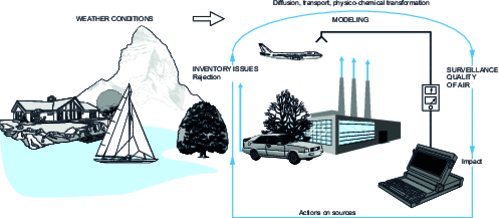Overview
Read this article from a comprehensive knowledge base, updated and supplemented with articles reviewed by scientific committees.
Read the articleAUTHOR
-
Jean-Pierre FONTELLE: Director, Centre interprofessionnel Technique d'études de la pollution atmosphérique (CITEPA) - National expert
INTRODUCTION
The Environmental Code grants everyone the right to breathe air that is not harmful to their health, i.e. air in which concentrations of substances that may be harmful to human health and other ecosystems do not exceed reference levels defined for this purpose.
Air quality is monitored via networks that measure concentrations of the substances concerned: SO 2 , NO 2 , CO, O 3 , VOCs (volatile organic compounds), lead... These networks, managed by approved air quality monitoring associations (AASQA), are mainly located in population exposure zones (conurbations, industrial zones...). They are made up of fixed sensors and laboratory trucks, supplemented by modeling tools to cover the entire geographical area concerned. AASQAs are mainly concerned with substances covered by European directives on air pollution. In recent years, the issue of health impact has become increasingly important, and actions are beginning to take shape (cf. Plan National Santé Environnement). As a result, the number of substances or compounds to be addressed is increasing.

Air concentration levels are indicators of the "state" of the environment. They depend on the extent of atmospheric emissions linked to human activities (heating, transport, etc.) and natural phenomena (volcanism, etc.), which are indicators of "pressure" on the environment.
The relationship between "pressure" (emissions into the atmosphere) and "state" (air quality) is complex to establish. This is because, on the one hand, the substances emitted are transported at varying distances from the source and, on the other, undergo multiple physico-chemical transformations, particularly under the action of solar radiation.
As part of their environmental...
Exclusive to subscribers. 97% yet to be discovered!
You do not have access to this resource.
Click here to request your free trial access!
Already subscribed? Log in!

The Ultimate Scientific and Technical Reference
This article is included in
Environment
This offer includes:
Knowledge Base
Updated and enriched with articles validated by our scientific committees
Services
A set of exclusive tools to complement the resources
Practical Path
Operational and didactic, to guarantee the acquisition of transversal skills
Doc & Quiz
Interactive articles with quizzes, for constructive reading
Air emission quantification methods
References
Useful contacts
Centre Interprofessionnel Technique d'Études de la Pollution Atmosphérique (CITEPA), centre national de référence sur les émissions dans l'air. http://www.citepa.org
Institut Français de l'Environnement (IFEN) http://www.ifen.fr
Agence de l'Environnement...
Exclusive to subscribers. 97% yet to be discovered!
You do not have access to this resource.
Click here to request your free trial access!
Already subscribed? Log in!

The Ultimate Scientific and Technical Reference